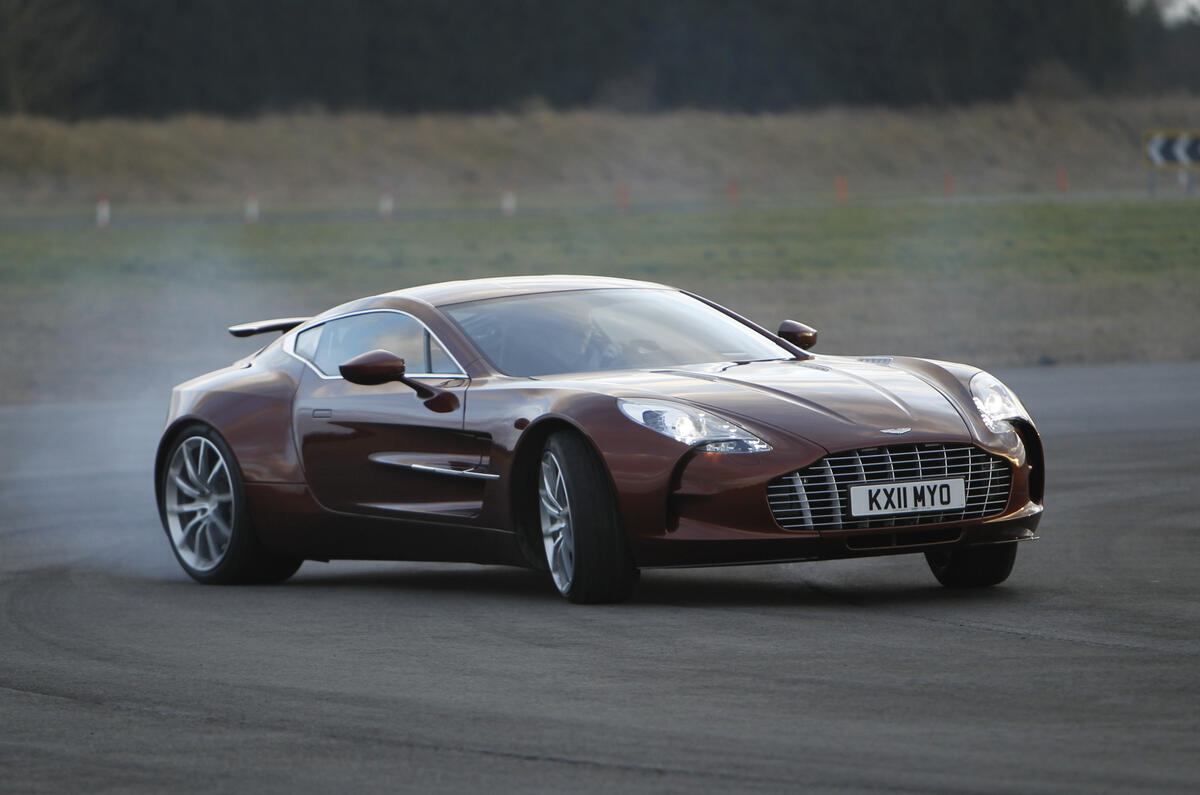As the speedo arced past 130mph, it suddenly stuck me that the approaching right-handed kink, which on every previous visit to Aston’s Gaydon test track I’d regarded as a benign sort of crooked straight, had rapidly turned into a bona fide corner, the kind of obstacle for which you must lose speed or regret it.
Yet we did not slow. Instead, the velocity of our Aston Martin One-77 kept rising at a rate I dimly calculated was more than quite spirited cars can manage below 60mph. This kink was about to turn into a crisis.
Video: See Steve Cropley riding in the Aston Martin One-77
Luckily, I remember thinking, the track was very wide: we could take a line. This, as the relentless acceleration continued, provided a second or two’s comfort. Then, right at the jaws of the bend, we stopped accelerating and I glanced again at the speedo – now just short of 160mph. A smooth suggestion of right lock and the car began to corner hard, then harder. Under what were now mighty cornering forces, it refused to roll, staying mysteriously, immaculately on line.
Dimly, over the vocal V12, I was aware of Pirelli scuffing well-worn bitumen for maybe five or six seconds: this kink was now a long bend. Then we were straight and accelerating strongly again, back on the power and heading for 200mph (we managed 192) until it was time for the carbon-ceramic pads to grab their discs and wash off 150mph in a couple of hundred yards so that we could negotiate the 180deg hairpin not far ahead. In the rush I missed much detail, but there was just time to note that my driver, Chris Porritt, chief engineer of the One-77 programme and a quality wheelman, had made his last gearchange, fifth to sixth, at a cool 180mph. We were in a potent car.
Extraordinary day
I had known all along that this was going to be an extraordinary day. Today, I was to do what no hack in Europe had so far managed: get my backside into the £1.4 million Aston One-77. The car is considered so exclusive that the company principal, Ulrich Bez, had decreed that no stranger would so much as ride in it until the 77-strong customer body had bought its cars, lest they be tainted or discouraged by something they read in the press.
Even today there would be no driving, but I was being offered the next best thing: a ride on the limit with the guy who had been involved in this car’s creation from the beginning, who knew, and could justify, its every design and engineering feature, and who could handle its 7.3-litre, 750bhp potential with an aplomb I was never going to acquire in a mere day at the wheel. Or a month…
When the car was commissioned roughly four years ago, says Porritt, the One-77 team was given two clear goals. First, it was to build the best, fastest, most technically advanced and most radical Aston the company could create, almost without regard to cost. Second, it was to investigate design routes and key technology that Aston might use in its next-generation models.


























Join the debate
Add your comment
Re: Aston Martin One-77: Riding shotgun
I don't know, luck certainly helps to make money but it obviously is useful in many other spheres of life and I know some wealthy men that I don't consider lucky at all!
Re: Aston Martin One-77: Riding shotgun
I don't consider this as a car in the traditional sense. It is more like an expensive piece of hand crafted jewellery which is closer to art than it is jewellery.
You could argue that there are plenty of other cars out there that will do the same or a better job but that is missing the point.
A rarity for the select few. Good luck to them!
Re: Aston Martin One-77: Riding shotgun
Not allowing any magazine to drive the car before the end of the production does not bode well for Aston guys. Weren't they that confident on their product? It looks like they have no spare money to develop new platforms, new engines, new gearboxes. They have loaned some money last year with a "junk" bond, which is trading in the secondary market like the company has not a bright future. The Virage was an embarrassment, an old DB9 with some makeup. In the medium term, without a strong partnership, it's going to be extremely tough for them.